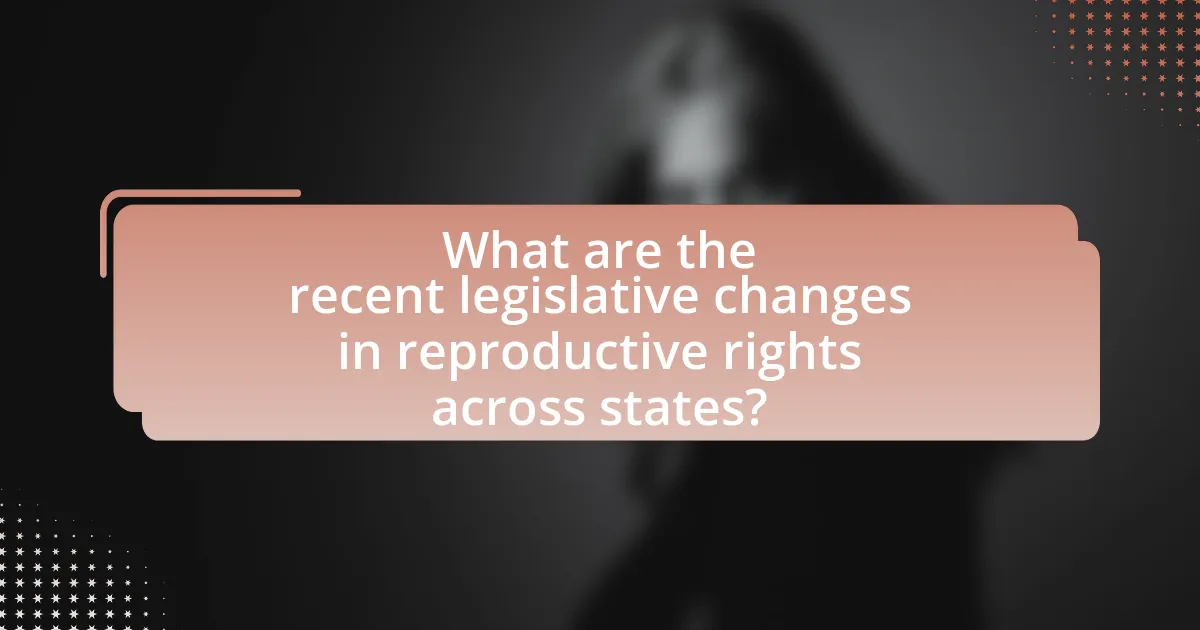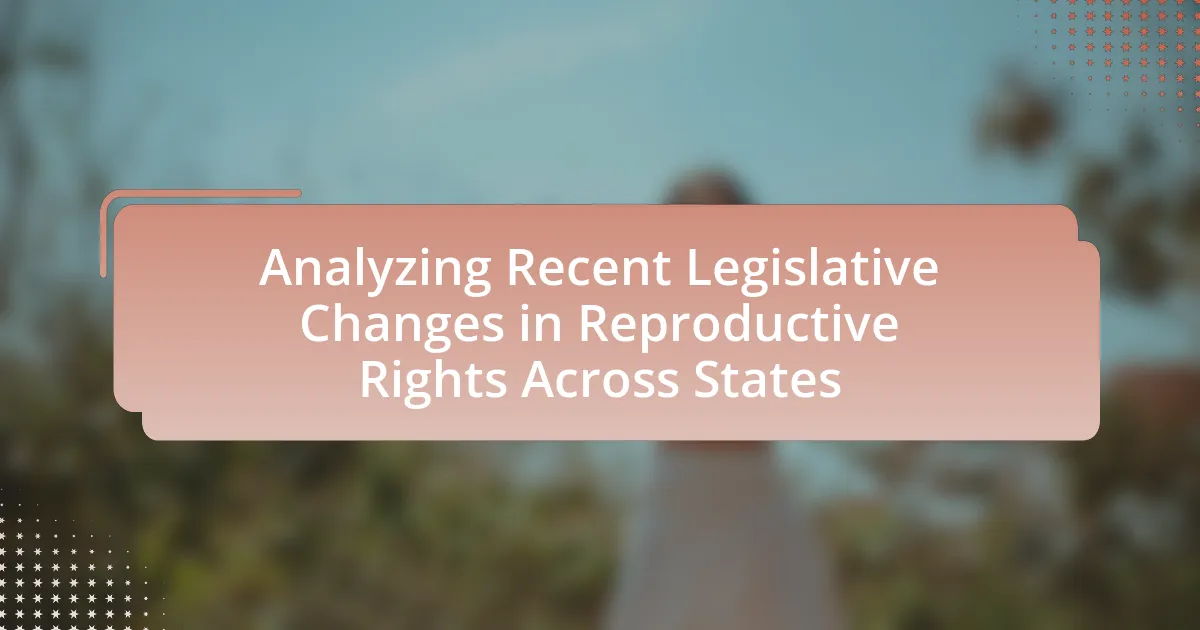The article analyzes recent legislative changes in reproductive rights across various states in the United States, particularly following the Supreme Court’s decision to overturn Roe v. Wade in June 2022. It highlights the stark contrast between states that have enacted stricter abortion laws, such as Texas and Florida, and those that have expanded protections for reproductive rights, like California and New York. The article examines the factors influencing these legislative differences, including political climates, cultural attitudes, and demographic variables, while also discussing the implications of these changes on women’s health, public opinion, and activism. Additionally, it provides insights into how individuals can stay informed about ongoing legislative developments and the role of advocacy groups in shaping reproductive rights legislation.

What are the recent legislative changes in reproductive rights across states?
Recent legislative changes in reproductive rights across states include the enactment of stricter abortion laws in several states, particularly following the Supreme Court’s decision to overturn Roe v. Wade in June 2022. For instance, states like Texas and Florida have implemented laws that significantly restrict access to abortion services, with Texas enforcing a near-total ban and Florida limiting abortions after 15 weeks of pregnancy. Conversely, states such as California and New York have expanded protections for reproductive rights, enacting laws to safeguard access to abortion and reproductive healthcare. These changes reflect a growing divide among states, with some moving towards increased restrictions while others enhance protections for reproductive rights.
How have these changes varied from state to state?
Recent legislative changes in reproductive rights have varied significantly from state to state, reflecting diverse political climates and public opinions. For instance, states like Texas and Alabama have enacted stringent abortion restrictions, including near-total bans, while states such as California and New York have expanded access to reproductive healthcare, including protections for abortion rights. According to the Guttmacher Institute, as of 2023, 13 states have implemented laws that severely restrict abortion access, whereas 16 states have enacted laws to protect or expand access. This stark contrast illustrates how local governance and societal values shape reproductive rights legislation across the United States.
What factors contribute to the differences in legislation among states?
Differences in legislation among states are primarily influenced by political, cultural, economic, and demographic factors. Political ideologies, such as conservatism or liberalism, shape legislative priorities and outcomes, leading to varying laws on issues like reproductive rights. Cultural attitudes, including religious beliefs and social norms, also play a significant role in determining state laws, as seen in states with strong religious influences enacting more restrictive reproductive legislation. Economic conditions, such as state budgets and funding for health services, can affect the availability and accessibility of reproductive health resources, further contributing to legislative differences. Additionally, demographic factors, including population diversity and urban versus rural populations, influence the political landscape and legislative focus, resulting in distinct legal frameworks across states. For example, states with larger urban populations may prioritize reproductive rights differently than rural states, reflecting the unique needs and values of their constituents.
How do political climates influence reproductive rights legislation?
Political climates significantly influence reproductive rights legislation by shaping the priorities and actions of lawmakers. In conservative political environments, there is often a push for restrictive measures, such as limiting access to abortion and contraception, as seen in states like Texas and Alabama, where recent laws have aimed to reduce reproductive rights. Conversely, liberal political climates tend to promote protective legislation, exemplified by states like California and New York, which have enacted laws to safeguard and expand access to reproductive health services. This dynamic is supported by the correlation between the political party in power and the legislative outcomes regarding reproductive rights, as evidenced by the National Conference of State Legislatures, which reports that states with Republican majorities are more likely to pass restrictive reproductive laws, while those with Democratic majorities are inclined to support pro-choice measures.
What are the key themes in recent reproductive rights legislation?
Key themes in recent reproductive rights legislation include increased restrictions on abortion access, the expansion of contraceptive access, and the protection of reproductive health services. Many states have enacted laws that impose waiting periods, mandatory counseling, and limitations on when abortions can be performed, reflecting a trend towards more restrictive measures. Conversely, some legislation aims to enhance access to contraceptives and reproductive health services, often in response to public demand for comprehensive reproductive care. Additionally, there is a growing emphasis on safeguarding reproductive rights against potential federal rollbacks, as seen in various state-level initiatives designed to protect access to abortion and contraceptive services. These themes highlight the ongoing national debate surrounding reproductive rights and the diverse approaches taken by different states in response to this issue.
What types of restrictions are being implemented?
Various types of restrictions are being implemented in reproductive rights across states, including gestational limits on abortions, mandatory waiting periods, and parental consent laws for minors. For instance, several states have enacted laws that prohibit abortions after a certain number of weeks, often around six to twelve weeks of pregnancy. Additionally, some states require individuals seeking an abortion to wait a specified period, typically 24 to 72 hours, before the procedure can be performed. Parental consent laws mandate that minors obtain permission from a parent or guardian before accessing abortion services. These legislative changes reflect a broader trend toward increasing restrictions on reproductive rights in various jurisdictions.
How are states expanding access to reproductive health services?
States are expanding access to reproductive health services by implementing policies that increase funding for clinics, expanding Medicaid coverage, and enacting laws that protect and enhance reproductive rights. For example, several states have increased state funding for family planning services, which directly supports clinics that provide essential reproductive health care. Additionally, states like California and New York have expanded Medicaid eligibility to cover a broader range of reproductive health services, ensuring that low-income individuals have access to necessary care. Furthermore, legislative measures in states such as Illinois and New Jersey have been enacted to safeguard reproductive rights, including the protection of abortion access and the provision of comprehensive sex education. These actions collectively demonstrate a commitment to improving reproductive health services and ensuring equitable access for all individuals.
Why is it important to analyze these legislative changes?
Analyzing legislative changes in reproductive rights is crucial because it directly impacts individuals’ access to healthcare and personal autonomy. These changes can lead to significant variations in reproductive health services across states, influencing public health outcomes and individual rights. For instance, the Guttmacher Institute reported that states with restrictive reproductive laws often see higher rates of unintended pregnancies and maternal mortality. Understanding these legislative shifts allows stakeholders to advocate for equitable access to reproductive healthcare and to inform public policy effectively.
What impact do these changes have on women’s health and rights?
Recent legislative changes in reproductive rights significantly impact women’s health and rights by restricting access to essential healthcare services, including abortion and contraception. These restrictions can lead to increased health risks, as studies indicate that limited access to reproductive healthcare correlates with higher rates of maternal mortality and morbidity. For instance, the Guttmacher Institute reports that states with more restrictive abortion laws often experience worse health outcomes for women, including higher rates of unintended pregnancies and unsafe abortions. Furthermore, these changes undermine women’s autonomy and decision-making power regarding their bodies, which is a fundamental aspect of gender equality and human rights.
How do these legislative changes affect public opinion and activism?
Legislative changes in reproductive rights significantly influence public opinion and activism by mobilizing individuals and organizations to advocate for or against these changes. For instance, after the Supreme Court’s decision to overturn Roe v. Wade in 2022, public opinion shifted, with a Pew Research Center survey indicating that 61% of Americans believed abortion should be legal in all or most cases. This shift prompted increased activism, as seen in the rise of grassroots movements and protests across various states, highlighting a direct correlation between legislative actions and public engagement. Furthermore, organizations like Planned Parenthood reported a surge in donations and volunteer sign-ups following restrictive laws, demonstrating that legislative changes can galvanize public sentiment and action.
What are the implications of these changes for future legislation?
The implications of recent legislative changes in reproductive rights across states indicate a potential shift towards more restrictive laws and increased state-level autonomy in regulating reproductive health. This trend may lead to a patchwork of laws that vary significantly from state to state, complicating access to reproductive healthcare for individuals, particularly in states that adopt more stringent measures. For instance, states that have enacted laws limiting abortion access often cite public opinion and political pressure as driving factors, suggesting that future legislation may continue to reflect these dynamics. Additionally, the Supreme Court’s decisions on reproductive rights can further influence state legislation, as seen in the overturning of Roe v. Wade, which has empowered states to enact their own laws without federal oversight. This evolving landscape underscores the importance of monitoring state legislative sessions for emerging trends and potential legal challenges that could reshape reproductive rights in the future.
How can individuals stay informed about reproductive rights legislation?
Individuals can stay informed about reproductive rights legislation by regularly following reputable news sources, subscribing to newsletters from advocacy organizations, and utilizing government websites that track legislative changes. Reputable news outlets like The New York Times and NPR often provide updates on significant legislative developments. Advocacy organizations such as Planned Parenthood and the American Civil Liberties Union (ACLU) offer newsletters and alerts that highlight changes in reproductive rights laws. Additionally, government websites, such as those of state legislatures, provide official information on proposed bills and enacted laws, ensuring individuals have access to accurate and timely updates.
What resources are available for tracking legislative changes?
Resources available for tracking legislative changes include government websites, legislative tracking services, and advocacy organizations. Government websites, such as Congress.gov and state legislative websites, provide official updates on bills and legislative activities. Legislative tracking services like GovTrack and LegiScan offer tools to monitor specific legislation and receive alerts on changes. Advocacy organizations, such as the Guttmacher Institute and the Center for Reproductive Rights, publish reports and analyses on legislative developments, particularly in reproductive rights. These resources ensure comprehensive access to current legislative information and facilitate informed engagement with ongoing changes.
How can advocacy groups influence reproductive rights legislation?
Advocacy groups can influence reproductive rights legislation by mobilizing public opinion, lobbying lawmakers, and providing resources for education and awareness. These groups often conduct campaigns that raise awareness about reproductive rights issues, which can shift public sentiment and pressure legislators to act. For instance, organizations like Planned Parenthood and the American Civil Liberties Union have successfully lobbied for the protection of reproductive rights through strategic partnerships and grassroots efforts, leading to legislative changes in various states. In 2021, advocacy efforts contributed to the defeat of restrictive abortion bills in states like Texas and Florida, demonstrating the tangible impact these groups can have on legislative outcomes.
What strategies can be employed to advocate for reproductive rights?
To advocate for reproductive rights, individuals and organizations can employ strategies such as grassroots mobilization, legal challenges, public education campaigns, and coalition building. Grassroots mobilization involves organizing community members to participate in rallies, demonstrations, and lobbying efforts, which can effectively raise awareness and influence policymakers. Legal challenges can be pursued to contest restrictive laws, as seen in cases like Whole Woman’s Health v. Hellerstedt, where the Supreme Court struck down Texas regulations that imposed undue burdens on abortion access. Public education campaigns aim to inform the public about reproductive rights and the implications of legislative changes, utilizing social media and traditional media to reach a broader audience. Coalition building among various advocacy groups enhances the strength of the movement, allowing for a unified front that can address reproductive rights from multiple angles, including health care, social justice, and gender equality.


